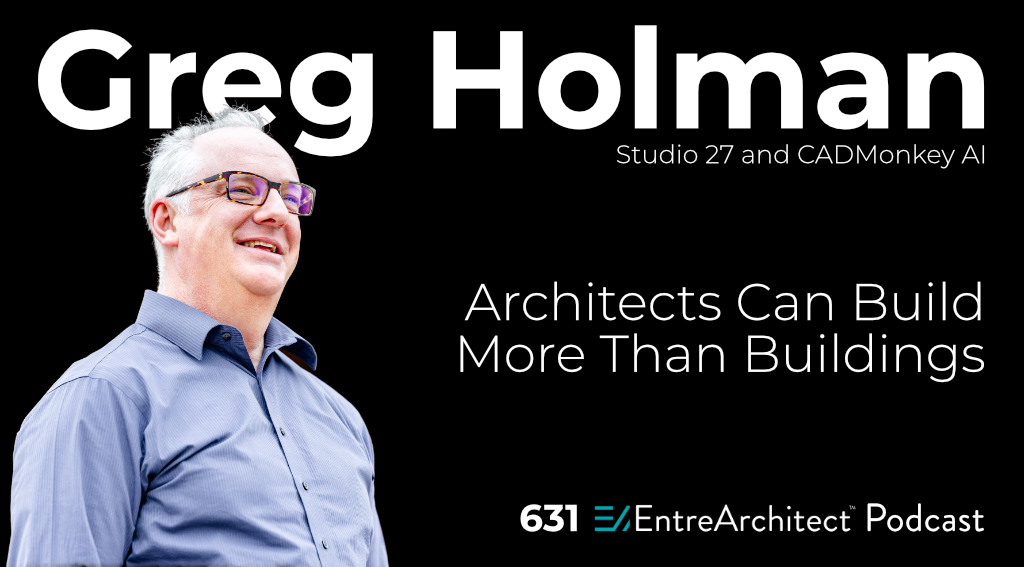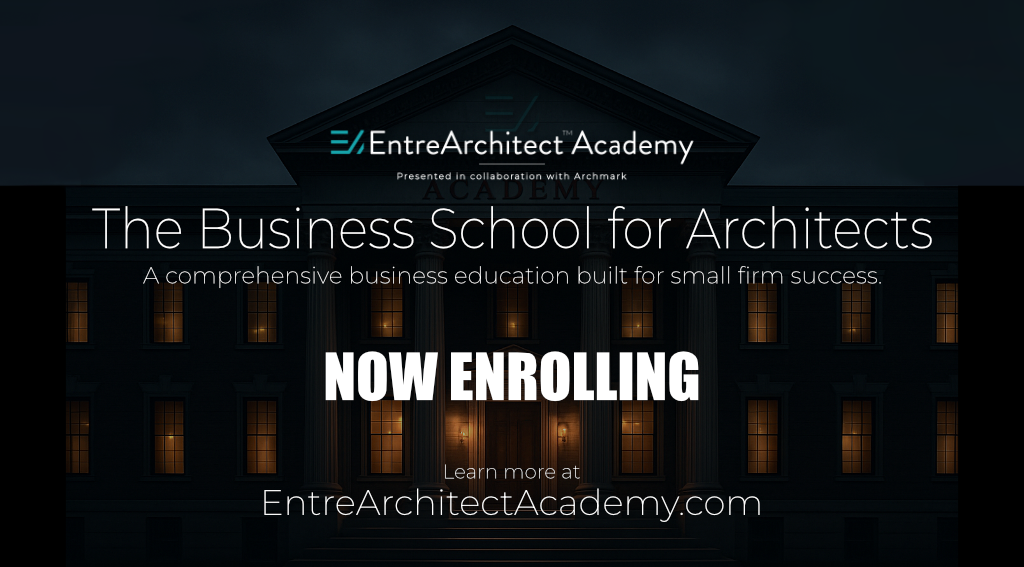
Lessons from Greg Holman on Innovation, Experimentation, and Expanding the Services Architects Provide
If there’s a consistent thread through more than six hundred episodes of the EntreArchitect Podcast, it’s this: small firm architects are some of the most inventive problem-solvers on the planet. Every day we design with limited time, limited budgets, and limited teams—but unlimited curiosity. That combination makes us natural entrepreneurs.
In my recent conversation with architect and entrepreneur Greg Holman, founder of Studio 27 in Roswell, New Mexico, that truth came alive once again. Greg didn’t set out to become a tech founder. He set out to make his firm more efficient. But like many small firm architects before him, he ran into a persistent friction—one that every architect reading this has felt—and decided to fix it himself.
His story offers something bigger than a single solution. It’s a model for how architects can think beyond drawings and buildings, and start developing new products, tools, and services that serve our industry—and open new paths for revenue, impact, and professional growth.
The Mindset Shift: From Practitioner to Builder of Systems
Greg’s journey started where many of ours begin: in the daily chaos of project delivery. Managing a small firm meant wearing every hat—designer, project manager, spec writer, business owner. Like so many of us, he saw hours vanish to repetitive technical work that didn’t move projects forward creatively or financially.
Rather than accept that frustration as “just the way it is,” Greg made a mental shift. He stopped looking at the problem as a workflow issue and started looking at it as a product opportunity. What if the tools architects needed didn’t exist yet? What if we could build them ourselves?
That shift—from practitioner to product thinker—is the core of the lesson. It’s what separates architects who constantly chase efficiency from those who invent it.
Seeing Problems as Product Opportunities
When Greg built the first prototype of what would become CADMonkey AI, he wasn’t thinking about venture capital or software launches. He was thinking about his next project deadline. He needed a faster way to connect details and specifications without combing through hundreds of manufacturer PDFs.
That problem—mundane and universal—is where innovation always begins. Architects who want to expand their services can start right there: with a friction point that drives them crazy.
Ask yourself:
- What do I do over and over again that should be easier?
- What knowledge do I have that others in my field or my community would pay to access?
- What would make my clients’ experience simpler, clearer, or more delightful?
If you start listing those answers, you’ll quickly see opportunities not just for better systems inside your firm, but for entirely new products or services—consulting offers, templates, digital tools, even software.
The Architect’s Advantage: We Already Know How to Build
Here’s the good news: architects are uniquely qualified to build products. We already understand systems, iteration, and design thinking. We take abstract ideas and make them tangible every day. The same process that leads to a well-detailed building can lead to a useful product or business.
Greg didn’t know how to code. He partnered with someone who did. What he brought to the table was clarity—the ability to define a problem precisely, describe the user experience, and test whether it worked. That’s what architects do.
The takeaway isn’t that every firm should go build software. It’s that our training gives us a framework for invention. Whether you’re creating a digital course, a design app, a prefab system, or a community platform, the steps are the same:
- Define the problem in measurable terms.
- Prototype something small.
- Test it with real users.
- Refine it through feedback.
This is the same iterative design loop we use on every project. We just need to apply it beyond buildings.
Why Small Firms Are the Best Labs for Innovation
Large firms often struggle to innovate because change takes too long to move through layers of approval. Small firms don’t have that problem. We can pivot fast. We can test ideas in real time.
Greg’s studio became his laboratory. Every inefficiency was a data point. Every new project was an experiment. That’s how CADMonkey evolved—from a spreadsheet of product links to a guided tool that helps architects make smarter technical decisions.
Think about what that means for your firm. You have access to daily, hands-on insight into the problems architects actually face. That proximity is a gift. If you learn to capture it—by documenting the challenges and small wins inside your workflow—you’ll uncover patterns. Patterns become systems. Systems become products.
You don’t need to leave architecture to innovate. You just need to see your firm as an R&D department.
Broadening What “Architectural Services” Means
Architects often define their work too narrowly. We think our value ends when the building is complete. But what if our services extended into every part of the building lifecycle—and beyond?
Greg’s story invites that question. His product doesn’t design buildings. It supports those who do. That’s still architectural service—it’s just delivered through a different medium.
Imagine if more architects did the same. What if your firm developed a simple energy modeling tool for local builders? What if you packaged your residential pre-design process into a digital workshop for homeowners? What if you launched a micro-consulting service that helps clients navigate zoning before they ever hire a full design team?
These are all extensions of what we already know how to do. They’re just expressed as products. And they can scale far beyond the hours we personally work.
Building the Courage to Experiment
The biggest barrier for most architects isn’t technical—it’s emotional. We were trained to deliver perfection, not prototypes. But the product world runs on iteration. The first version is never the final one.
Greg shared openly that his first AI prototype was rough. It didn’t automate much. It wasn’t elegant. But it worked well enough to prove a point. Each test revealed the next improvement.
If you’re thinking about developing something new, don’t wait for a perfect version. Make something useful today. Offer it to your clients or peers. Gather feedback. Adjust.
Perfectionism is the enemy of innovation. Progress is what matters.
The Business Case for Innovation
There’s a practical reason to expand our services: stability. Architecture is cyclical. When the market slows, firms with multiple income streams survive.
Creating a new product or service doesn’t just serve others—it protects your business. Greg still runs Studio 27, but now his innovation work adds a complementary revenue path. The same can be true for any firm that chooses to diversify.
Here are a few examples from other small firm owners in our community:
- Jennifer Kretschmer, AIA created online courses and videos that help homeowners understand how to hire and work with an architect — expanding her influence and generating new revenue beyond design services.
- Earl Parson of Clever Moderns turned his expertise in desert modern design into a thriving digital business selling Homestead House Plans and providing online guidance for DIY homebuilders.
- Marcos Santa Ana of Alloi Architecture + Construction developed a design-build model that integrates prefab construction systems to deliver higher-quality projects with greater efficiency.
- Chris Novelli of n3 Architecture built successful podcast and YouTube channels that attract new clients and generate additional income—showing how sharing knowledge publicly can both grow a practice and diversify firm revenue.
None of these architects stopped designing. They simply built additional products that serve the same mission: to improve how people experience architecture.
Lessons for Firm Owners Ready to Innovate
Greg’s journey offers a clear set of lessons for any architect ready to move from frustration to innovation.
1. Start with empathy. Innovation begins with care—care for your team, your clients, and your peers. Greg didn’t build his tool to get rich. He built it to help people like him save time and reduce risk.
2. Focus on one pain point. You don’t need to reinvent the profession. Fix something small but meaningful. When you solve a real problem for a few people, word spreads.
3. Build partnerships. You don’t need every skill. Find collaborators who complement yours—developers, marketers, engineers, or other architects.
4. Test in the real world. Don’t overthink. Release early, learn, and refine. Architecture teaches us iteration; innovation rewards it.
5. Align it with your values. Greg’s company operates under three principles: Be kind. Be exceptional. Be a servant. That clarity keeps his business grounded. Build your own project on the same foundation.
Reimagining the Architect’s Role
We talk a lot about the “value gap” in architecture—the disconnect between what we provide and what the market recognizes. Expanding our services is how we close that gap.
When architects create new tools, processes, and platforms, we increase our relevance. We show that our expertise applies beyond drawings. We lead the industry instead of following it.
That’s what excites me most about Greg’s story. It’s not about AI or code. It’s about reclaiming our role as inventors, as people who imagine better ways of working and living. When we apply that creativity inward—to how we practice—we build a stronger profession.
The Future Is Built by Small Firms
The next wave of innovation in architecture won’t come from big firms or tech startups. It will come from small teams like yours—people close to the work, who understand the problems deeply and move fast to solve them.
AI and automation will continue to reshape our tools, but they won’t erase our need for human judgment. The firms that thrive will be those that learn to combine the two: human creativity and machine efficiency.
Greg’s example shows what happens when an architect takes initiative instead of waiting for someone else to build the solution. His path reminds us that our value is not just in what we draw—it’s in what we create.
A Final Thought for the Small Firm Architect
If you take nothing else from Greg’s story, take this: innovation isn’t optional anymore. The architects who adapt, who experiment, who turn their frustrations into products and systems—those are the ones who will define the next decade.
You don’t have to start with AI. Start with something simple and useful. Write down the ten most time-consuming or confusing parts of your firm’s workflow. Choose one. Solve it. Share the result.
That’s how transformation begins.
To hear Greg Holman’s full story and our conversation about innovation, small firm practice, and how architects can start building their own tools, listen to the full episode at https://entrearchitect.com/631.

Leave a Reply